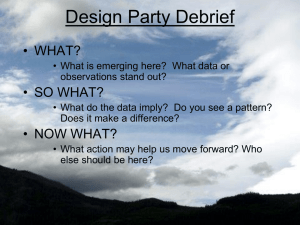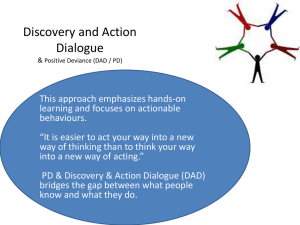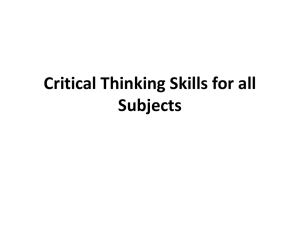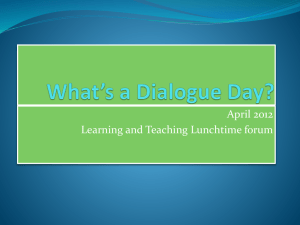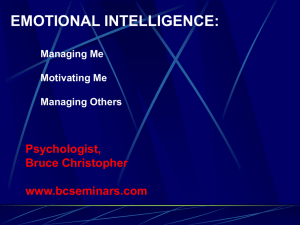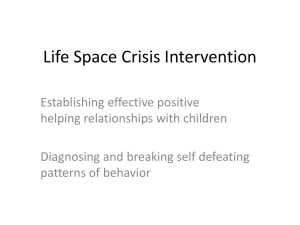Life Space Crisis Intervention Overview (LSDI)--K. Frederick
advertisement
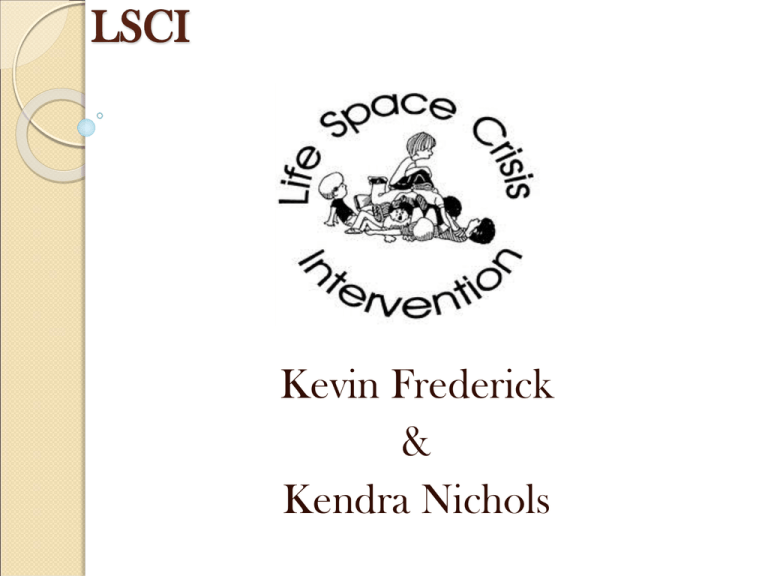
LSCI Kevin Frederick & Kendra Nichols LIFE SPACE CRISIS INTERVENTION A therapeutic skill which enables us to make the best out of a stressful student incident when we get the worst of it. 3 Possible Outcomes of a Crisis Staff-Student Relationship IMPROVED Staff-Student Relationship UNCHANGED Staff-Student Relationship DAMAGED CRISIS WHAT IS THE CAUSE OF THE CRISIS? An event that triggers a student’s self-concept A child’s self-concept develops from the on-going feedback he gets from significant adults and peers in life regarding the kind of person he is. Over time, the child learns a specific way of thinking about him or herself. He begins to make certain assumptions and develop certain beliefs about him or herself. The child also develops a personal set of beliefs about the people in their world and what they are going to do with them. They result in a characteristic way of perceiving, feeling, thinking, and behaving in all current and future situations. It can become the foundation of his/her self-concept or character. “I can’t do anything right” vs. “I’m good at things” “I have to be in control of everything to survive” vs. “I can let things happen” “Teachers care about me” vs. “Teachers don’t care.” FOUR TYPES OF STRESS 1) Developmental: The stress that results from life cycle issues we all face; separation, learning, achievement, belonging, independence, physical development, etc… 2) Psychological: The stress that results when someone is conscious or inadvertently depreciated or ridiculed or made fun of, etc… 3) Reality: The stress that results from things that shouldn’t go wrong, but do go wrong each day that make life difficult. 4) Physical: The stress that results from deprivation of basic biological and physical issues like nutrition, sleep deprivation, over-stimulated, physical injuries, etc… STAGES OF CHILD DEVELOPMENT Developmental Stage Existential Question Irrational Beliefs if Not Resolved Abandonment (Birth – 2 years old) “Is the world a safe place?” “I can’t trust anyone but myself—I’ll do whatever it takes to meet my needs?” Inadequacy (3 – 5 years old) “Can I measure up to my parents’ expectations?” “I’ll never measure up, so why try?” Guilt (6 – 9 years old) “Can I measure up to my own expectations?” “I’m no good, so I deserve to be punished!” Conflict (9 – 12 years old) “Can I be accepted by my peers?” “I’m an outcast, so screw them all!” Identity (12 years old – Adulthood) “Do I have what it takes to become the kind of adult I want to be?” “I don’t have what it takes to make it; I’m lost!” Irrational Beliefs or Cognitive Distortions “I must be good at everything – otherwise I am a failure.” “Everybody ought to like me – or I am a loser.” “If people don’t do things I like they are bad people – and they must be punished.” “Everything must go my way all the time – otherwise I must be unimportant.” Irrational Beliefs or Cognitive Distortions “Everyone must treat me fairly all the time - because I am entitled to it.” “I never have any control over what happens to me in my life - and therefore I am not responsible for my problems.” “When something bad happens to me I can never forget it - and I must think about it all the time.” 7 Defense Mechanisms 1) Denial- When an individual protects himself or herself from unpleasant aspects of reality by ignoring or refusing to perceive them, remaining unaware of facts that could create one side of a conflict. 2) Regression- When an individual retreats to an earlier developmental level involving less mature responses and a lower level of aspiration. 3) Withdrawal- Involving emotional, intellectual, or physical retreat from a situation. Rationalization- Socially approved reasons to justify past, present, or proposed behavior are used. Helps to justify actions and beliefs, and it aids in softening disappointment connected with unattainable goals. 4) 5) Sublimation- The acceptance of a socially approved substitute goal for a drive whose normal channel of expression or normal goal is blocked. 6) Projection- A transfer of blame for shortcomings, mistakes, and misdeeds to others or attributes to others his or her own unacceptable impulses, thoughts, and desires. 7) Displacement- When a shift of emotion, symbolic meaning, or fantasy from a person or object toward which it was originally directed to another person or object. THE 6 STAGES of LSCI DIAGNOSTIC STAGES STUDENT CRISIS Staff de-escalating skills to drain off the student; intense feelings while controlling one’s counter-aggressive reactions Stage 1 STUDENT TIMELINE Stage 2 RRRR Staff relationship skills to obtain and validate the student’s perception of the crisis STUDENT CENTRAL ISSUE Stage 3 Staff diagnostic skills to determine if the crisis represents one of six patterns of self-defeating behavior. RECLAIMING STAGES STUDENT INSIGHT Stage 4 Staff clinical skills to pursue the student’s specific pattern of selfdefeating behavior for personal insight and accountability STUDENT NEW SKILL Stage 5 Staff empowering skills to teach the student new social skills to overcome their pattern of self-defeating behavior STUDENT TRANSFER OF TRAINING Stage 6 Staff consultation and contracting skills to help the student reenter the classroom and to reinforce and generalize their new social skills Stressful Event EVENT Adult/Peer Reaction CYCLE 1 INGREDIENTS OF THE CONFLICT CYCLE INCIDENT Student Feelings Student’s Observable Behavior Stressful Event Adult/Peer Reaction CYCLE 2 INCIDENT EXPANDS Student Feelings Student’s Observable Behavior Stressful Event Adult/Peer Reaction CYCLE 3 Student’s Observable Behavior Student Feelings CRISIS 7 Essential Questions When 2) Where 3) Target 4) Duration 5) Frequency 6) Intensity 7) Contagion 1) FOUNDATIONS OF LSCI Developing the Art of Listening Attending Responding Decoding Attending Skills Entering the Dialogue Attending: Being fully present with the student; attending to verbal and non-verbal communication. Deepening the Dialogue Attending: Remaining fully present; being aware of one’s own verbal and non-verbal messages to the student. Responding Skills Entering the Dialogue Responding: Keeping the dialogue going; reducing stress; remaining non-judgmental; building trust. Deepening the Dialogue Responding: Affirming; checking for understanding; creating a sense of mutual problem-solving. Decoding Skills Entering the Dialogue Decoding: Searching for the meaning behind the message; “listening” to what is not being said. Deepening the Dialogue Decoding: Connecting feeling and behavior; adding more meaning; leading student to insight. Remember, During a crisis, act like a thermostat…not like a thermometer. The Difference in Psychological Worlds Between a Student in Stress and a Helping Staff… THE PROCESS STAFF REACTION STUDENT REACTION PERCEIVING DIVERSE MULTIDEMENSIONAL CONCRETE ONE DEMENSIONAL THINKING LOGICAL COGNITIVELY-BASED ILLOGICAL IRRATIONAL TRAP FEELING ACCEPTS AND CONTROLS FLOODED EXPLOSIVE BEHAVING ACCEPTS RESPONSIBILITY FOR BEHAVIOR DOES NOT ACCEPT RESPONSIBILITY FOR BEHAVIOR THE MOST IMPORTANT THING WE CAN DO TO HELP A CHILD IS TO ALWAYS TREAT THEM WITH RESPECT….EVEN WHEN THEY’RE DISRESPECTFUL! They will not remember what we said….. They will not even remember what we did….. But they will never forget how we made them feel. -Maya Angelou How you say it is more important than what you say… Facial Expression 55% Tone of Voice 38% Words 7% Good Morning Timothy The Art of Decoding On his first visit to kindergarten, while mother was still with him, Bruce, age five, looked over the paintings on the wall and asked loudly, "Who made these ugly pictures?“ Mother was embarrassed. She looked at her son disapprovingly and hastened to tell him, "It's not nice to call the pictures ugly when they are so pretty.“ The teacher, who understood the meaning of the question, smiled and said, "In here you don't have to paint pretty pictures.You can paint mean pictures if you feel like it." A big smile appeared on Bruce's face, for now he had the answer to his hidden question: "What happens to a boy who doesn't paint so well?“ Next Bruce picked up a broken fire engine and asked self-righteously, "Who broke this fire engine?“ Mother answered, "What difference does it make to you who broke it? You don't know anyone here.“ Bruce was not really interested in names. He wanted to find out what happened to boys who break toys. Understanding the question, the teacher gave an appropriate answer: "Toys are for playing. Sometimes they get broken. It happens.“ Bruce seemed satisfied. His interviewing skill had netted him the necessary information: "This grownup is pretty nice. She does not get angry quickly, even when a picture comes out ugly or a toy is broken. I don't have to be afraid. It is safe to stay here." Bruce waved good-bye to his mother and went over to the teacher to start his first day in kindergarten. ESCALATING THE CONFLICT CYCLE Stop “YOU” messages! • • • • • • • • • • • Can’t you do anything right? With your attitude you’ll never amount to anything! You apologize immediately! Don’t you dare speak to me like that! Why do you have to be so disgusting? You need to start acting your age! You have no respect for anyone or anything! You don’t listen to anyone, do you? You are a disappointment to me, your friends, and your family. You never use your head! You’re more trouble than you’re worth. Student’s Self-Fulfilling Prophesy Once the adult responds in counter-aggressive, hostile, withdrawn or rejecting ways the student’s self-fulfilling prophesy ( SFP) is reinforced and strengthened. The stage is set for the next interaction. The SFP is a troubled student’s way of validating their beliefs and programming adults to behave in hostile ways. DE-ESCALATING THE CONFLICT CYCLE “I” messages are… Less likely to provoke more aggression. Less threatening to others. A model of honest exchange between people. More likely to open up communication. Helpful in interrupting a power struggle. Helpful in releasing adult stress in a helpful way. When you use “I messages” you are modeling coping behavior and respect. Students are more inclined to listen. 4 Adults Choices in Responding to Student Behavior 1) Permit it 2) Tolerate it 3) Stop it 4) Prevent it KIDS IN STRESS CREATE IN ADULTS THEIR FEELINGS, AND IF NOT TRAINED, THE ADULTS WILL MIRROR THEIR BEHAVIOR. DON’T PICK UP THE ROPE! Why We Become Counter-Aggressive Caught in the conflict cycle Being in a bad mood Personal irritability Embarrassed for not meeting our professional expectations. Fury due to personal helplessness. Student behavior triggers our own unfinished business. Pre-judging a troubled student. Student violates our middle class values. “I have come to the frightening conclusion that I am the decisive element. It is my personal approach that creates the climate. It is my daily mood that makes the weather. I possess tremendous power to make life miserable or joyous. I can be a tool of torture or an instrument of inspiration, I can humiliate or humor, hurt or heal. In all situations, it is my response that decides whether a crisis is escalated or de-escalated, and a person is humanized or de-humanized. If we treat people as they are, we make them worse. If we treat people as they ought to be, we help them become what they are capable of becoming.” -Haim Ginott How Can I Avoid the Power Struggle? Nine Surface Management Strategies 1) 2) 3) Planned Ignoring- If the behavior is not reinforced, it will fade. Proximity Control- Moving around the classroom while teaching can prevent the problem from starting. Signal Interference- Quietly communicating to the student that you are aware of the behavior that’s leading to trouble can stop it before it becomes a bigger problem. Nine Surface Management Strategies (Continued…) 4) 5) 6) Interest Boosting- Learning activities that appeal to a student’s interest helps keep him/her on task and out of trouble. Support from Routine- A predictable environment reduces anxiety. Support from Cognitive Restructuring- An adult who can read the feeling tone of the group can help change the perception from “glass half empty” to “glass half full”. Nine Surface Management Strategies (Continued…) 7) 8) 9) Direct Appeal to Values- The group can have a positive influence on a members’ behavior. Support Through Humor- Humor can sometimes attract students’ attention away from a growing problem. Antiseptic Bouncing- As a student’s emotions begin to mount, re-direct him/her to another activity that can break the behavior chain. SOMETIMES KIDS MAKE YOU FEEL LIKE A Don’t take it personally and Don’t get angry….That’s what they want! Debrief (Drain off) with staff, family, or friends. Take care of yourself!
